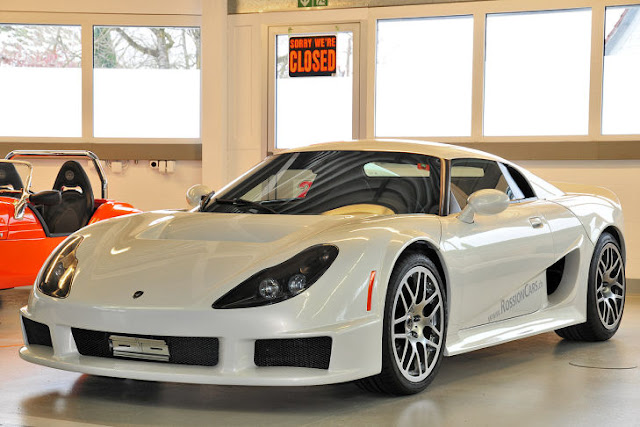ROSSION
Q1
Caranddriver.com
When
Noble stopped producing the M400, Dean Rosen and Ian Grunes (co-owners of 1G
Racing, which imported the South African–built Noble chassis) purchased the
manufacturing rights to the M400. They moved the shop from Ohio to sunny
Florida, came up with a new name for the business—Rossion (pronounced
ROSS-e-yon) Automotive—by mashing their names together, and immediately started
developing the Q1, a car based on the M400.
Although
the Q1’s silhouette and proportions are similar to the Noble’s, the fiberglass
body is new except for the M400’s windshield. Rossion cleaned up the interior
by boxing in the previously exposed roll cage and overhauled the suspension,
changing the spring rates and the shock valving and adding a rear toe-control
link in the process.
The
car needed new suspension tuning because, while the Q—at 2600 pounds—weighs 100
pounds more than the M400, Rossion claims to have shaved 28 pounds of unsprung
weight from the corners, with help from forged 18-inch wheels. The Q1 chassis
engineer then tuned the suspension on the “on-ramps of south Florida.” This is
no joke: Without access to a proving ground, he used public roads and I-95
on-ramps to dial in the suspension setup.
Knowing
this, we were surprised to find the Q1 capable of a balanced 1.09 g on the
skidpad while riding on sticky Michelin Pilot Sport Cup tires. That’s better,
by 0.07 g, than the M400. Even more surprising is the Q1’s ability to soak up
rough sections of road.
Don’t
misread this: The car is stiff—stiffer than any modern Porsche. But the tuning
relays a message of security to the driver. Midcorner bumps don’t invoke ajarring
bump steer that might toss the car sideways or generate a moment of uneasiness
(there is no stability control to catch mistakes). The steering, much like a
Lamborghini Murcielago’s, has some low-speed slop but loads nicely, boosting
confidence when the car is pushed.
As
with all kit cars, the chassis and the powertrain must be sold separately, and
the owner must assemble the pieces or pay to have it done. Rossion charges
$73,500 for a base chassis, sans air conditioning ($2956). The company
recommends a 450-hp, twin-turbocharged Ford 3.0-liter V-6 hailing from AER
Manufacturing ($4300) mated to a six-speed Getrag transaxle ($5500). Another
$12,995 must be coughed up to get an installation kit (plumbing, wiring, Garrett
turbochargers, heat exchangers, etc.). Rossion figures another $4300 to have
everything installed by a professional wrench if the new owner chooses against
attempting the 45-odd-hour assembly himself.
On
a cool day, we struggled to get power to the ground, and so the launch
suffered. The best we could manage was 3.4 seconds to 60 mph, just behind the
3.3-second time we got in a 425-hp M400 [March 2007]. After 80 mph, the Q1
takes over and is quicker than the M400 in the quarter by 0.1 second, at 11.6.
The Q1 hits 120 in 10.0 seconds, matching the 638-hp Corvette ZR1 and bettering
a Ferrari 430 Scuderia. “Stupid fast” holds.
That
is a whole lot of good. However, when looking at the cost, we feel like we just
ate a superb meal and got a check with four digits when we were expecting one
with three. The Q1’s base price eclipses an eye-blinking $100,000. With options
(A/C, metallic paint, colored-leather interior bits, and nav), the price hits
$106,416. That’s a lot of bread for a car that comes with assembly
instructions. But everything has its cost. Like one of those belt-loosening
meals, you exit the Q1 with a euphoric buzz, feeling satisfied but toting a
significantly lighter wallet.









